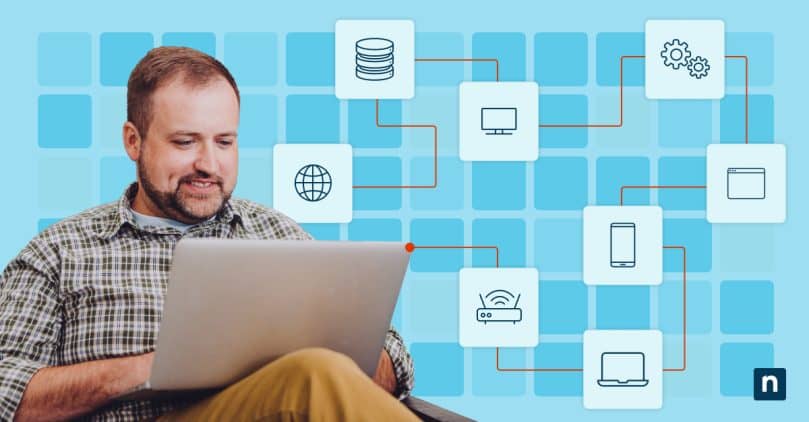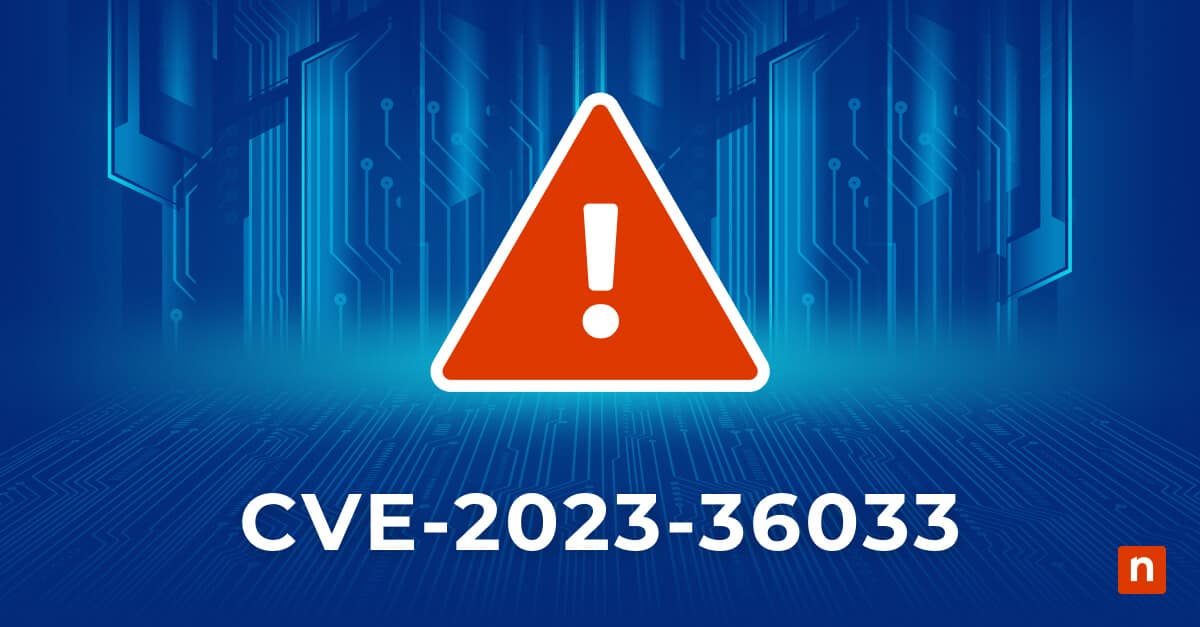Simply defined, Information Technology (IT) is the use of computers and related technology, such as software, cloud-based applications, and networks to communicate or transmit data, build organizational infrastructure, and secure information. Anything a business or organization uses an endpoint device for could technically be classified as IT.
In this guide, we’ll discuss the basics of IT in the modern workplace, hardware and software, the essential functions of IT, backups and security, management, and troubleshooting. Each of these topics will leave you with a better understanding of that component of infrastructure and its applications in the workplace.
Why is Information Technology important?
IT is an essential part of most business operations, and when executed well, it improves productivity, efficiency, and innovation. Many organizations and departments use IT for things like remote connectivity, data storage and transmission, and accessibility and security, among others. All of these capabilities make using information and technology much easier, faster, and more convenient. With more time and a wide range of technology options on their hands, employees are better able to focus on innovation rather than logistics.
Digital transformation, the process of integrating technology into multiple aspects of a business, is rapidly occurring in many organizations. Without IT support, this process would be haphazard and disorganized. However, because IT professionals are able to set up protocols and policies that manage and monitor environments, digital transformation can be done successfully.
Automated tasks improve efficiency, and data analysis can improve organizational strategic planning. Its importance to the smooth operation of most organizations should not be understated, especially for companies that work in the transportation, healthcare, and financial industries, or any other industry that requires smooth, accurate, and fast data transmission.
If the growth of the field and the demand for IT professionals is any indication, IT is very important to the continued growth and success of most companies. The field is growing more quickly than many other industries; some estimates state that job growth in the field could rise 33% between 2020 and 2030, and the average salary is between $50,000 and $120,000 annually, depending on the position. The future of many organizations depends on digital transformation and IT infrastructure.
Hardware vs. software
The distinction between hardware and software is a simple one: Hardware refers to the devices that individuals use, and software refers to the programs run on the hardware. For example, an application like Microsoft Word is a piece of software that is typically run on a device like a Windows PC that contains hardware like a central processing unit, motherboard, or hard drive.
There are several hardware components that you should be familiar with to understand IT. Each of these is essential for an infrastructure based on technology to work.
- Central Processing Unit (CPU): A CPU is the device inside a computer that reads electrical signals to receive and transmit instructions. It receives its instructions from software and delivers instructions to other hardware components.
- Hard drive: The hard drive provides data storage, holds your operating system, and stores applications. Binary-encoded information can be read or written by electrical and magnetic fields.
- Random access memory: This component is used for temporary storage. Because the information loaded on it can be accessed and changed much more quickly than information on a hard drive, activities are completed using RAM and later stored on the hard drive.
- Motherboard: A large circuit board that holds other components, including the CPU and hard drive. It transmits power to each of those components and assists with communication.
Software is also needed for IT. The most common types work together with the hardware components to facilitate productivity and efficiency.
- System software: This refers to the operating system of a machine, which is stored on the hard drive and moved to the RAM when needed to function. The operating system is then able to run programs (application software) by sending instructions to the CPU.
- Application software: Most of what you do throughout the day happens in an application. Word processors, spreadsheets, web browsers, and any other application that you use is considered application software. Applications run on RAM, and when you save your data, it is written to the hard drive via electrical pulses.
- Utility software: This is background software, such as anti-virus or other security programs. It also includes optimization and disk cleanup software. Utility tools run on the hard drive and are generally not especially noticeable to the user.
Core functions of information technology
Within organizations, IT performs a large number of functions that are becoming increasingly essential for business continuity and market competitiveness.
IT governance
IT governance focuses on aligning organizational goals with IT. It’s important for IT professionals to be in tune with the goals and priorities of their organization so that any projects or upgrades will support those goals. Additionally, careful budgeting and resource allocation are important for aligning with company objectives.
For successful IT governance, carefully manage and mitigate risks, comply with organizational standards, and create your own goals and policies that support the strategy of the rest of the organization. Best practices for IT governance include ensuring that your IT-related decisions are adding value, monitoring activity consistently, and assessing your abilities and limits.
IT operations
Many IT professionals have found that their daily operations, being frequently basic and sometimes tedious, can be delegated to IT Operations Management (ITOM). This is a solution that helps automate many aspects of IT operations, including key processes such as monitoring endpoints for problems, monitoring the network, tracking events or incidents, and securing devices.
ITOM helps IT teams automate monitoring their environment, which provides early problem detection. It also helps technicians provide remote support, deploy patches and updates, and troubleshoot without disrupting workflow or requiring travel time. All of these benefits work together to save organizations time, money, and personnel resources. Ultimately, the team becomes more effective while also becoming more efficient.
Cybersecurity
From malware and phishing attacks to ransomware and data leaks, the possibilities for attack are almost endless. Cybersecurity measures contribute to securing organizations’ data and networks from threats and vulnerabilities, and this is an essential part of the IT professional’s role. Failure to adequately secure assets and data can result in expensive downtime, data loss, and resulting fines or litigation. It can also create an increased risk of identity theft for employees and customers.
As organizations increasingly rely on cloud-based applications and data storage, the possible attack surface grows. Many applications are built on open-source code, which allows attackers the opportunity to review and test the code before breaking into your environment. This means IT teams need to be on top of patching and updating at all times to maximize cybersecurity, particularly in a cloud or hybrid environment. Additional cybersecurity measures for all environments include automated monitoring and alerts, access controls, and strong credentials.
Data security and database management
Data storage is a favored target of attackers as the data can be sold or ransomed for considerable amounts of money. Aside from patches, updates, and other aforementioned protective measures, Database Management Systems (DBMS) can help with visibility and control. Visibility means that you’re aware of all of the data stored in your database; if you don’t have visibility, attackers may find that data and exploit it.
Many IT teams have more work than they can reasonably do to keep up with patch management processes, monitoring access and proper storage, and security. Regular patches are essential as they minimize the number of vulnerabilities that an attacker will be able to successfully exploit. However, it’s important to understand the role that access control plays in data security.
Especially when dealing with sensitive data, it’s wise to use principles of zero-trust and need-to-know access. When fewer people have access to information, there are fewer possible attack vectors. IT providers sometimes monitor access logs or set up automated alerts for anomalies as an unusual activity pattern or access point may indicate compromised credentials. In IT, catching a problem as early as possible is far better than catching it later.
Data backup and recovery
To protect against ransomware or natural disaster, most organizations use data backups. These backups are a critical component of disaster recovery strategies, so the important thing for an IT service provider is to ensure that client backups are running regularly and that the content is usable when downloaded. Having at least two extra copies of data could save your organization from major losses following a disaster.
However, the type of backup an organization chooses is often tailored to that organization’s needs. Some have implemented cloud-based backups and file storage only while others prefer a local backup or hybrid model. Whatever way the client chooses, the IT technician should always explain the pros and cons to each and ensure that all backups are running as scheduled.
Network management
It’s often challenging to secure a single data point, which means that it can be very challenging to secure an entire network. However, network management is important for boosting security, and it’s necessary for any connected device to follow network security protocols so that the device does not become reinfected. Network management can also include performance monitoring of employees.
Virtualization
To improve flexibility, many machines offer virtualization, which is software that can run programs and do other activities like a typical machine. Essentially, it creates a virtual computer and all its components. There are some benefits to this, like cost savings and increased IT team productivity due to the lower number of servers needed in an organization. Virtualization means that multiple operating systems can be stored on one machine, which reduces the number of servers that need to be purchased and maintained.
Software troubleshooting
A critical component of the IT team’s job is software troubleshooting. To do this, technicians will often run automated checks, but for more complex issues they may need to do things like double check code for errors or complete a hard restart on the devices. This is an extremely important daily task as bug-free software is essential for continued business operations and security. You aren’t going to get much done if your application won’t save a file, for example.
Device management
Finally, do not underestimate the power of effective device management and mobile device management (MDM). All devices go through a lifecycle in which they start as typically low-maintenance assets. As they get older, the devices tend to need more maintenance or may need to be retired altogether. Some IT professionals use IT Asset Management (ITAM) to effectively monitor active devices and their status in the lifecycle. As with many things IT-related, if it’s a simple task that can be automated, it probably should be.
The importance of understanding IT
As a large and complex field, IT has many facets, from device management to data protection to integrated operations. IT teams have a nearly endless supply of challenges and projects that can be done, but many of the tedious tasks can be accomplished more easily through automated tools like ITAM, ITOM, and remote monitoring and management solutions.
Since the world is becoming increasingly dependent on digital and virtual technologies, understanding IT is useful. If you are interested in the field, having a good grasp of its fundamentals and functions can help you become a successful technician. Even if you aren’t interested in working in IT, being able to troubleshoot your own issues and automate some of your monitoring tasks could be useful in other contexts. In a world full of devices, everyone should learn the basics to efficiently use and fix them.








